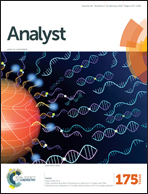Nicking endonuclease-assisted recycling of target–aptamer complex for sensitive electrochemical detection of adenosine triphosphate
Abstract
An electrochemical biosensor was developed for the detection of adenosine triphosphate (ATP) based on target-induced conformation switching and nicking endonuclease (NEase)-assisted signal amplification. The electrochemical biosensor was constructed by base pairing and target recognition. After capture DNA hybridized with the gold electrode, a significant current of Methylene Blue (MB) was obtained by differential pulse voltammetry. In the presence of ATP, the hairpin DNA formed a G-quadruplex structure due to the specific recognition between hairpin DNA and ATP. Then the exposed part of the target–aptamer complex hybridized with the 3′-terminus of capture DNA to form a specific nicking site for Nb.BbvCI, which led to NEase-assisted target–aptamer complex recycling. The released target–aptamer complex hybridized with the remaining capture DNA. Nb.BbvCI-assisted target–aptamer complex recycling caused the continuous cleavage of capture DNA with MB at its 5′-terminus, resulting in release of a certain amount of DNA fragment labeled with MB. Then the current value decreased significantly. The reduced current showed a linear range from 10 nM to 1 μM with a limit of detection as low as 3.4 nM. Furthermore, the proposed strategy can be used for the detection of similar substances.


 Please wait while we load your content...
Please wait while we load your content...